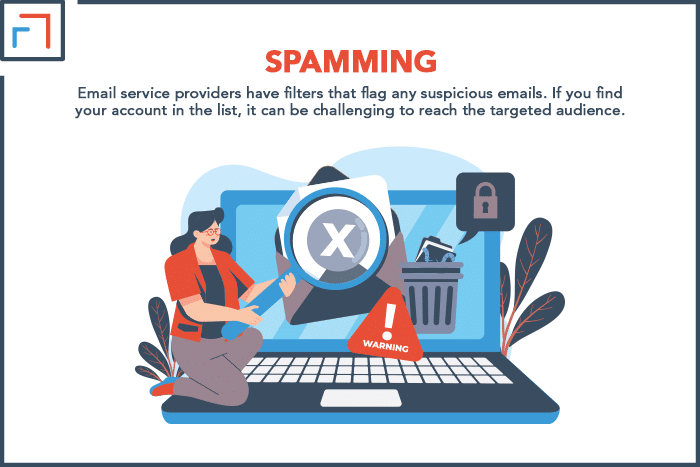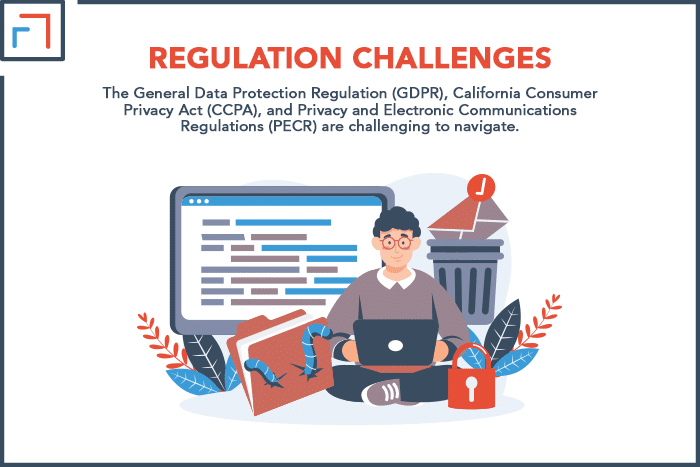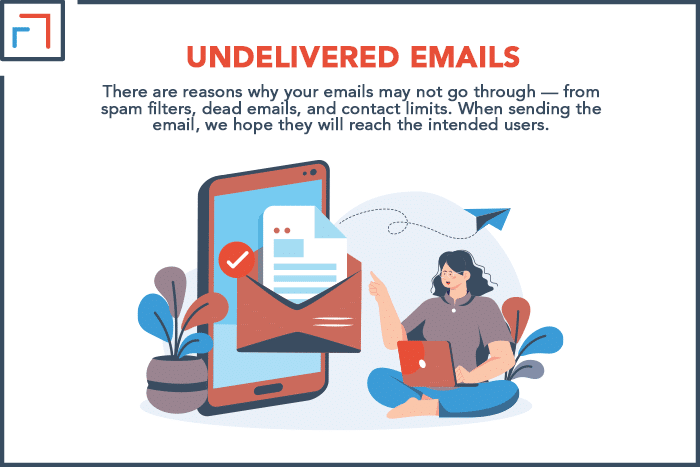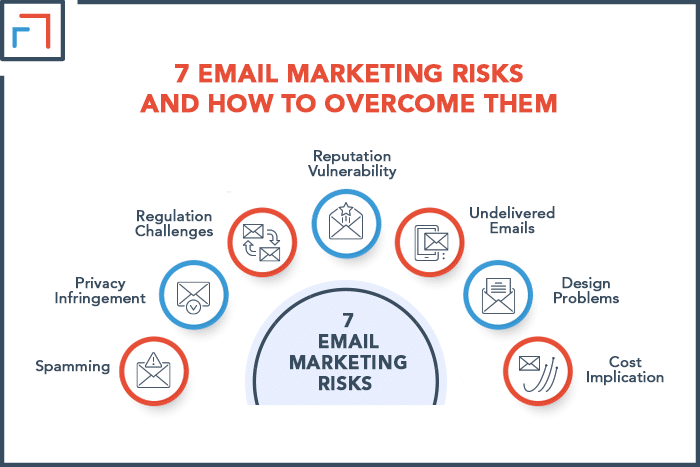Emails are arguably the most effective marketing method for all businesses. Whether you want to target prospects in the awareness or action stage, you can never go wrong with email campaigns. But they are not without risks and challenges.
Risks of email marketing include spamming and privacy infringement because unsolicited messages can irritate recipients and tarnish your brand image. Apart from that, there are regulatory challenges. Other risks include undelivered emails, design problems, and cost implications.
Keep reading to know these challenges and how you can overcome them.
7 Email Marketing Risks and How to Overcome Them
1. Spamming
Email service providers have filters that flag any suspicious emails. If you find your account in the list, it can be challenging to reach the targeted audience.
Your emails can also be flagged as spam if the unsubscription rate is high or receivers block you. Your email frequency increases the chances of being flagged as spam.
So, create a schedule that does not irritate your contacts.
My article on email frequency by industry will help you find the right number of emails you should send over a period. My suggestion is to stay under the radar rather than flirting with the boundaries.
Another menace that has infiltrated the marketing industry is buying email contacts.
The practice not only increases your spam score but is also against CAN-SPAM Act. You should grow your email list organically to avoid blocks and negative reports.
You can use spam score tools to assess your performance. The metric helps you to know the type of emails that are unpleasant to your audience.
Sending emails to inactive and dead email accounts can increase your spam score. To avoid this, you should regularly clean up your contact list and eliminate unfunctional addresses.
Addressing any concerns from your contacts can also save the day. The feedback you receive gives you first-hand information about what prospects feel about your communication.
Most email marketers hide the unsubscribe button or do not have one. But it is counterproductive to keep a list of uninterested contacts.
You should have a clear link or button for those who want to exit your email list to improve the engagement rate.

2. Privacy Infringement
Privacy is becoming a significant concern with constant breaches, even from giant companies. Companies like Facebook and Google have faced serious hurdles over using and disposing of customer data.
Most marketers have limited information on how far they can go using contact information. This makes the risk of infringement a reality you need to face not to break customer trust.
You should use customer data for the purpose it is meant to serve only.
For instance, if the objective was to send a weekly newsletter, you should stick to that. You can allow your contacts to select their preferences to avoid any conflict.
Who can access your contact list? Most privacy breaches occur because there is no accountability for access.
So, if the information lands in the wrong hands, it could be used for all the wrong reasons or, even worse, sold to competitors.
You should have clear guidelines on contact list management. This includes who is responsible, who can access it, and for what reason. With clear regulations, you reduce the risk of privacy infringement.
3. Regulation Challenges
The General Data Protection Regulation (GDPR), California Consumer Privacy Act (CCPA), and Privacy and Electronic Communications Regulations (PECR) are challenging to navigate.
First, most staff don’t know or understand these regulations.
These regulatory bodies have strict laws governing personal information collection, storage, and use. Some of the most violated terms include:
- Explicit consent to collect contact information
- Precise opt-in and opt-out mechanisms
- Maintaining a detailed record of consent
- Allowing subscribers to edit or delete their information
Because of the ever-evolving nature of regulations, most companies cannot keep up with the pace. To make it worse, the guidelines may differ from one state or country to another.
The first step in avoiding non-compliance risk is to set up an internal framework that guides data protection. Your staff should understand how to protect any information under your custody.
You should train staff on privacy best practices, data handling procedures, and the importance of compliance with relevant regulations.
Regular communication and awareness campaigns can reinforce the significance of privacy protection within the organization.

4. Reputation Vulnerability
In an interconnected world, one mistake could bring down a reputation you have built over the years. Sending an email means putting your brand on the line and hoping for positive results.
But there are instances you can miss the target.
Marketers have shared instances when they thought the contact was male or female, and it was the opposite, and their messages came out as gender-biased.
Your email jokes can also bounce back on you and create opposite results. In short, many things can go wrong.
You should be transparent and adhere to email etiquette to manage your company’s reputation.
Before communicating, you should proofread and test the copy to maintain a consistent and professional brand image.
Knowing that not all your contacts will like your emails can also help manage expectations. You can address complaints when they arise and avoid exposing your company.
Taking time to verify the information in your email can also save your reputation. You should identify the source and ensure it is reliable.
5. Undelivered Emails
There are reasons why your emails may not go through — from spam filters, dead emails, and contact limits.
When sending the email, we hope they will reach the intended users. However, the rate of delivery is usually not 100%.
Internet and email service providers can flag your address when you have a low delivery rate. You can implement authentication protocols like SPF, DKIM, and DMARC to avoid emailing inactive users.
There are also certain words, like free and $$$, that trigger spam filters. So, identifying spammy words and phrases in your industry can prevent flagging.
You should also monitor your list to weed out any dead emails. The practice also helps you to segment your list depending on the open and click-through rates.

6. Design Problems
You can test an email design on one device, and it is okay, but it fails to work on another. When an email is incompatible with a device, it could lead to unsubscription or end up in the spam folder.
You should take time to test your email on different devices. Because most users open emails on mobile, you should prioritize smartphones.
You can also allow the receivers to open the email on a browser for a better user experience.
The type of content can also affect how the email appears. Images and videos can fail to load if your contacts have a limited network connection. This could lead to ineffective communication.
Your buttons and links should be prominent to inspire the desired action. Make the CTA stand out from the rest of the text.
7. Cost Implication
Sending an email comes at a cost; it could be time or money. Although emails have a high return on investment, you will not always get enough income to cover the expenses.
Some of the most common expenditures in email marketing include purchasing email marketing software, hiring copywriters, and managing your list.
Calculating all the costs can help you maximize the returns from your campaigns.

Email Marketing Works – But Only for the Wise
Email marketing comes with risks and challenges that you should be aware of.
These risks include spamming, privacy infringement, regulation challenges, reputation vulnerability, undelivered emails, design problems, and cost implications.
To mitigate these risks, you should build a clean and engaged email list, adhere to privacy regulations, and understand and comply with relevant laws.
You should maintain a positive brand image, optimize email deliverability, ensure user-friendly design across devices, and manage costs efficiently.
